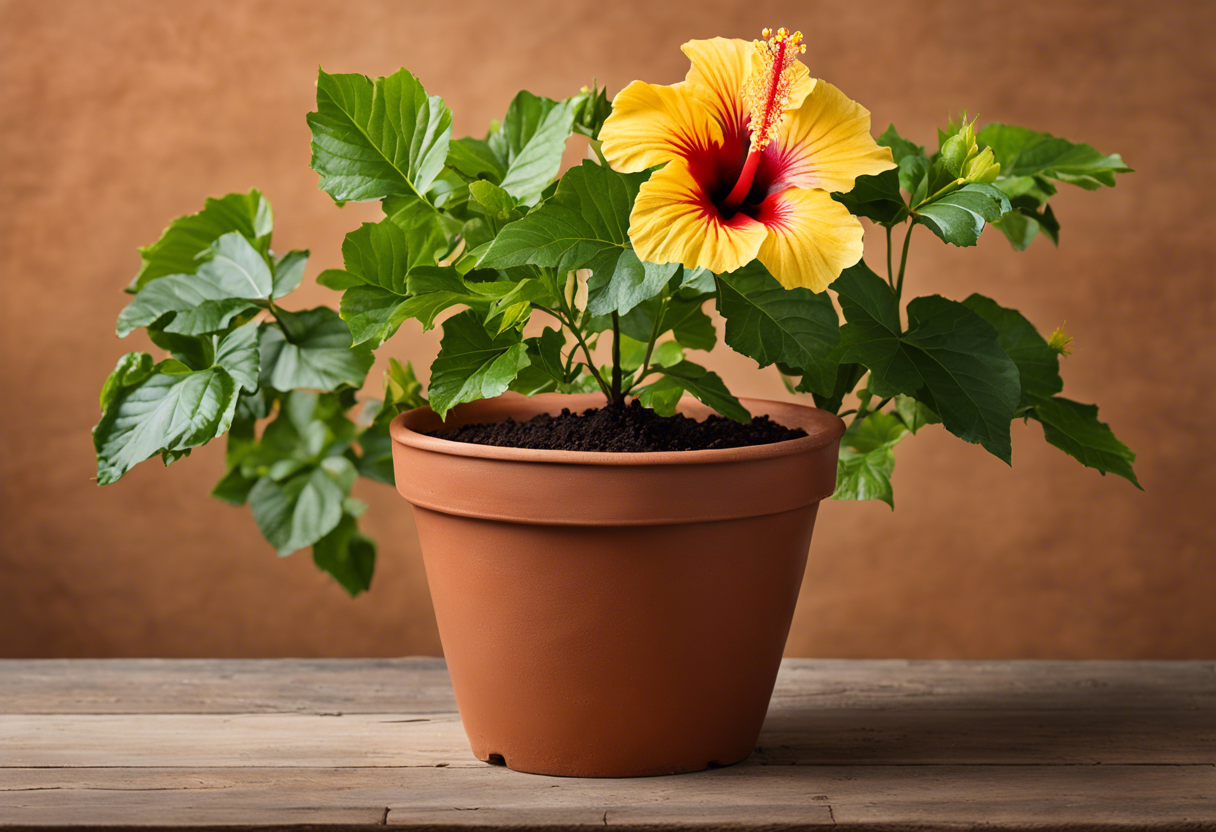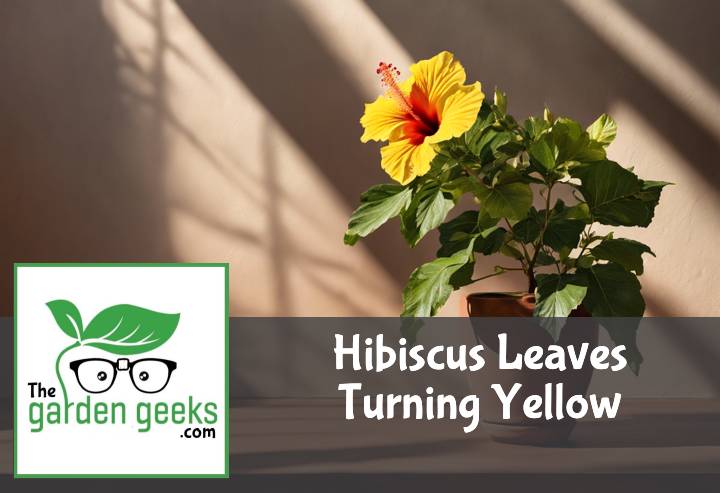Have you ever had one of those moments where you’re admiring your vibrant, tropical Hibiscus Leaves Turning Yellow and suddenly notice a disheartening change? The once lively green leaves are now taking on an alarming shade of yellow. It’s enough to make any plant parent break out in a cold sweat!
But don’t start panicking just yet! A hibiscus turning yellow might seem like a disaster, but it’s often a sign your plant is trying to communicate with you. So, buckle up, fellow green thumbs. We’re about to embark on a botanical journey to revive your yellowing hibiscus leaves! Keep reading about Hibiscus Leaves Turning Yellow? (How to Revive it)
Key Takeaways
- Yellowing hibiscus leaves can be due to overwatering, underwatering, or nutrient deficiencies.
- Overwatered plants have yellow leaves with brown spots, while underwatered ones have uniformly yellow leaves.
- Nutrient deficiency symptoms include yellow leaves with green veins (iron deficiency) or purple undersides (phosphorus deficiency).
- Revive your hibiscus by adjusting watering practices, ensuring proper drainage, and supplementing with appropriate nutrients.
- Monitor the plant’s progress and adjust care as necessary.

Understanding Hibiscus Plant
The Hibiscus plant, with its vibrant flowers and lush leaves, is a sight to behold. But it’s not just about looks. To keep this beauty blooming, understanding the hibiscus plant characteristics and its needs is key.
What is a Hibiscus Plant?
A Hibiscus plant is a tropical flower known for its large, colorful blossoms. Originating from Asia and the Pacific islands, it’s now found worldwide. There are over 200 species, but the most common ones include the Chinese hibiscus and the Rose of Sharon.
Importance of Healthy Leaves for Hibiscus
Healthy leaves are like the lifeblood of a hibiscus plant. They play a crucial role in photosynthesis, which fuels the plant’s growth. So when you see your hibiscus leaves turning yellow, it’s time to take action! Maintaining leaf health ensures your hibiscus stays vibrant and thriving.
Why are Your Hibiscus Leaves Turning Yellow?

Well, there could be a few reasons for hibiscus leaves turning yellow. It might be due to the natural aging process, nutrient deficiencies, watering issues, pests, or diseases. Let’s dive into these hibiscus plant problems and find some yellowing hibiscus leaves solutions.
Natural Aging Process
First off, don’t panic! Some yellowing in hibiscus plants is perfectly normal. As part of the life cycle of a hibiscus plant, older leaves will naturally turn yellow and fall off. This is just the hibiscus aging process doing its thing.
Nutrient Deficiencies
But sometimes, it’s not just age. Your hibiscus might be having a bit of a dietary problem. A nutrient deficiency in hibiscus plants can cause those lovely green leaves to turn yellow. Often, it’s a lack of iron or nitrogen that’s the culprit – essential nutrients for healthy hibiscuses.
Overwatering or Underwatering
Watering can also be tricky business when it comes to hibiscuses. Both overwatering and underwatering can lead to leaf yellowing. So what’s the Goldilocks amount? Well, your plant needs enough water to keep its soil moist but not soggy – that’s the sweet spot for those healthy green leaves.
Pest Infestation
Pests are another common cause of leaf yellowing in hibiscuses. Those little critters can suck the life out of your plant (literally!). Common culprits include aphids and spider mites – they’re tiny but mighty when it comes to causing damage! Dealing with these infestations early is key to keeping your plant healthy.
Disease and Fungal Infections
Last but not least, diseases and fungal infections can also cause yellowing leaves in hibiscus plants. These nasties can spread quickly if not treated, so it’s important to keep an eye out for any signs of disease. Prevention is always better than cure, but if your plant does get sick, there are treatments available to help it bounce back.

How to Diagnose the Cause of Yellowing Leaves?
When your hibiscus leaves turning yellow, it’s a cry for help! Identifying the root cause is crucial. It could be anything from soil conditions to pesky pests. So, let’s play detective and figure out what’s causing this hibiscus leaf yellowing diagnosis.
Observing Symptoms and Patterns
Start by observing your hibiscus. Look for patterns in the yellowing of the leaves. Are they all over or just on certain branches? This hibiscus symptoms observation can give you clues about what’s going wrong.
Next, keep track of any changes in your plant’s health. A sudden change might indicate a serious issue. Remember, pattern recognition in plants is key to identifying problems early.
Soil Testing for Nutrient Levels
The next step in our hibiscus health check is soil testing. Your hibiscus might be hungry! Poor nutrient levels in the soil can lead to yellow leaves.
A simple soil test can reveal if there’s a deficiency causing those yellow leaves. It’s like a blood test but for plants! Keep an eye on that soil health for hibiscus, folks!
Checking for Signs of Pests or Disease
Finally, don’t forget about pests and diseases. These uninvited guests can wreak havoc on your hibiscus, leading to yellow leaves.
Inspect your plant closely for signs of infestation or disease. If you spot anything suspicious, act fast! Remember, prevention is better than cure when it comes to pest control and disease prevention in plants.
Reviving Your Yellow Hibiscus Leaves
So, your hibiscus leaves turning yellow got you scratching your head, huh? Don’t fret! It’s a common hibiscus leaf problem. The good news is that with some hibiscus care and a bit of detective work, we can get to the root of the issue. Whether it’s adjusting watering practices, correcting nutrient deficiencies, treating pest infestations or addressing diseases and fungal infections – we’ve got you covered!
Adjusting Watering Practices
Let’s start with water – too much love can be a bad thing! Overwatering your hibiscus can lead to yellow leaves. But don’t go from flood to drought – underwatering has similar symptoms. So what’s the right amount?
Well, it depends on the weather and soil type. Generally, keep the soil moist but not soggy. A good rule of thumb is to water deeply but less frequently. This encourages roots to grow deeper into the soil for moisture. Remember, proper watering techniques for hibiscus are key in preventing water stress in plants.
Correcting Nutrient Deficiencies
Next up: food! Or rather nutrients… Just like us humans, plants also need a balanced diet. If your hibiscus is showing signs of nutrient deficiency like yellow leaves, it might be time for a check-up.
First off, let’s identify what’s missing. Are the older leaves turning yellow first? That could be a nitrogen deficiency. Or maybe it’s the new growth that’s affected? That points towards an iron or zinc deficiency.
Once you know what’s missing, you can correct nutrient imbalances in the soil using fertilizers or composts tailored to your plant’s needs. Remember folks; managing plant nutrition isn’t rocket science – just pay attention to those leaves!
Treating Pest Infestations
Now, let’s talk about uninvited guests. Pests! They’re not just annoying; they can cause serious damage to your plants. Common pests in hibiscus plants include aphids, whiteflies and spider mites.
If you notice yellow leaves along with tiny bugs or a sticky residue on the leaves, you might have a pest problem. Don’t panic though – there are plenty of pest control options for garden plants. From insecticidal soaps to neem oil sprays, you can show these pests the exit door!
Addressing Diseases and Fungal Infections
Lastly, we need to consider health issues – plant health that is! Diseases and fungal infections can also cause hibiscus leaves turning yellow.
Common culprits include root rot (caused by overwatering) and various leaf spot diseases (usually caused by fungi). If you suspect your plant is sick, it’s best to consult with a local nursery or extension service for advice on treatment.
Prevention is always better than cure though – so keep an eye out for early signs of trouble. After all, nothing beats a healthy hibiscus with vibrant green leaves!
Preventive Measures to Keep Hibiscus Healthy
Preventive measures are the secret sauce to maintaining hibiscus health. It’s all about proper watering, regular fertilization, and effective pest control. These hibiscus care tips can help you avoid the dreaded hibiscus leaves turning yellow.
Proper Watering Techniques
Watering your hibiscus properly is crucial. Too much or too little water can lead to yellow leaves in hibiscus plants.
The trick is understanding your hibiscus water requirements. They love moist soil but hate being waterlogged.
So, how do you strike a balance? Well, ensure the top inch of soil dries out before watering again. This way, you’re not overwatering your hibiscus, which often causes yellow leaves.
Regular Fertilization Schedule
Next up on our list of hibiscus preventive measures is regular fertilizing. A consistent fertilization schedule for hibiscus ensures they get all the nutrients they need.
When feeding your plant, use a balanced fertilizer designed for flowering plants – it’s the best choice for your hibiscus.
Remember that over-fertilizing can be as harmful as under-fertilizing. So stick to a schedule and don’t go overboard with it!
Pest Control Methods
Finally, let’s talk about pests – every plant owner’s nightmare! Effective pest control is key in keeping your hibiscus healthy and free from diseases that cause yellow leaves.
Regularly inspect your plant for signs of pests like aphids or whiteflies. If you spot any, act fast! Use an insecticidal soap or neem oil spray to nip the problem in the bud.
Remember, prevention is better than cure when it comes to pest control in hibiscuses. So, keep an eye out and act swiftly at the first sign of trouble!

To Wrap Up
Just like a detective solving a mystery, we’ve unraveled the enigma of Hibiscus Leaves Turning Yellow. It’s all about understanding what your hibiscus is trying to tell you and responding accordingly.
So, don’t let your plant’s yellows get you down! With a bit of TLC and the right know-how, you’ll have your hibiscus blooming like a summer sunset in no time.


